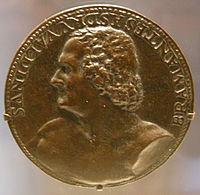

Cristoforo (known as Caradosso) Foppa (1445 – c. 1527) was an Italian goldsmith, sculptor, and die sinker.
Biography
According to some sources he was born at Olgiate Molgora (in the frazione of Mondonico) in the Province of Lecco, and according to others in Pavia. It is possible that this artist is not correctly known as Ambrogio, but that his Christian name was Cristoforo.
He was in the service of Lodovico Il Moro, Duke of Milan, for some years, and executed for him a medal and several pieces of goldsmith's work. He worked in Hungary in the service of King Matthias Corvinus, probably in August 1489; a later visit to the court was cut short by the King's death in 1490. Later on he is heard of in Rome, working for Popes Julius II and Leo X.
His will was executed in 1526 and he is believed to have died in the following year.
Works
Giorgio Vasari refers at some length to a medal struck by him in Rome, having upon it a representation of Bramante and his design for St. Peter's Basilica, and he speaks of him as "the most excellent goldsmith of that time, who has no equal in the execution of dies". He is said by some to have been responsible for the terracotta reliefs in the sacristy of San Satiro in Milan. In addition to the Bramante and Moro medals, three others are attributed to him, one representing Julius II, another the fourth Duke of Milan, Francesco Sforza, and the third Gian Giacomo Trivulzio.
A large number of examples of goldsmith's work in the sacristies of the various churches of Italy are attributed to Foppa with more or less uncertainty. They especially include reliquaries, morses, and crosiers. He was responsible for a papal mitre made for Pope Julius II, a drawing of which is held at the Department of Prints and Drawings at the British Museum and was executed at the request of an English collector named John Talman. An inaccurate engraving of it by George Vertue is also in existence, and this was reproduced by Muntz in his article on the papal tiara. He declared that the pope told his master of ceremonies that it cost two hundred thousand ducats. It survived the sack of Rome through the accident of its being in a pawn shop at the time, but was deliberately broken up and refashioned by Pope Pius VI. Foppa is believed to have designed several pendant jewels, but there is uncertainty respecting his goldsmith's work, and little can be attributed to him with authority.
Notes
- "Caradosso Foppa Artwork for Sale at Online Auction | Caradosso Foppa Biography & Info".
- Freiberg, Jack (2017). "Bramante's Portrait Medal: Classical Hero / Christian Architect". Artibus et Historiae. 76: 145–155 – via JSTOR.
- However, others attribute these to Agostino de Fondulis.
- See Thurston in the "Burlington Magazine" for October, 1895.
References
 This article incorporates text from a publication now in the public domain: Herbermann, Charles, ed. (1913). "Ambrogio Foppa". Catholic Encyclopedia. New York: Robert Appleton Company.
This article incorporates text from a publication now in the public domain: Herbermann, Charles, ed. (1913). "Ambrogio Foppa". Catholic Encyclopedia. New York: Robert Appleton Company.
Further reading
- Clifford M. Brown; Anna Maria Lorenzoni (2001). "Caradosso Foppa and the Roman Mint". Artibus et Historiae. 22 (43): 41–44. doi:10.2307/1483650. JSTOR 1483650.
- Clifford M. Brown (1997). "The Archival Scholarship of Antonino Bertolotti. A Cautionary Tale: The Galeazzo Mondella (Moderno) Model for a Diamond "Saint George" Brooch". Artibus et Historiae. 18 (35): 65–71. doi:10.2307/1483538. JSTOR 1483538.
- Freiberg, Jack (2017). "Bramante's Portrait Medal: Classical Hero / Christian Architect". Artibus et historiae. 76: 145–155.